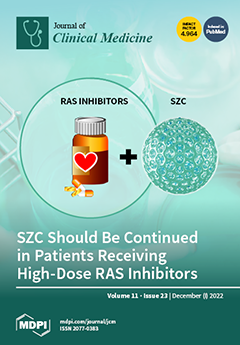Background: Skeletal muscle mass (SMM) has been suggested to be associated with multiple health-related outcomes. However, the potential influence of SMM on asthma has not been largely explored. Objective: To study the association between SMM and clinical features of asthma, including asthma control
[...] Read more.
Background: Skeletal muscle mass (SMM) has been suggested to be associated with multiple health-related outcomes. However, the potential influence of SMM on asthma has not been largely explored. Objective: To study the association between SMM and clinical features of asthma, including asthma control and exacerbation, and to construct a model based on SMM to predict the risk of asthma exacerbation (AEx). Methods: In this prospective cohort study, we consecutively recruited patients with asthma (
n = 334), classified as the SMM
Normal group (
n = 223), SMM
Low group (
n = 88), and SMM
High group (
n = 23). We investigated the association between SMM and clinical asthma characteristics and explored the association between SMM and asthma control and AEx within a 12-month follow-up period. Based on SMM, an exacerbation prediction model was developed, and the overall performance was externally validated in an independent cohort (
n = 157). Results: Compared with the SMM
Normal group, SMM
Low group exhibited more airway obstruction and worse asthma control, while SMM
High group had a reduced eosinophil percentage in induced sputum. Furthermore, SMM
Low group was at a significantly increased risk of moderate-to-severe exacerbation compared with the SMM
Normal group (relative risk
adjusted 2.02 [95% confidence interval (CI), 1.35–2.68];
p = 0.002). In addition, a model involving SMM was developed which predicted AEx (area under the curve: 0.750, 95% CI: 0.691–0.810). Conclusions: Low SMM was an independent risk factor for future AEx. Furthermore, a model involving SMM for predicting the risk of AEx in patients with asthma indicated that assessment of SMM has potential clinical implications for asthma management.
Full article






